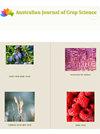Cultivation of ruziziensis grass (Urochloa ruziziensis) using swine liquid manure fertilization
Q3 Agricultural and Biological Sciences
引用次数: 0
Abstract
The objective of this study was to evaluate the use of liquid swine manure (LSM) as fertilization in the implantation of Urochloa ruziziensis. The experimental design was randomized blocks with five treatments and four replications, with the treatments being four doses of LSM (0; 100; 200 and 300 m 3 ha -1 ) and one dose of mineral fertilization. Seven cuts were carried out uniformly, after which plant height (PH), total dry mass yield (TDMY), crude protein content (CP), neutral detergent fiber (NDF) and acid detergent fiber (ADF), macromineral extraction (N, P, K, Ca, Mg and S) and microminerals (Fe, Zn, Mn and Cu) of plants were evaluated every 30 days. Mineral fertilization provided higher PH, CP content and extraction of N and S, but lower NDF content. For ADF variable, there was no difference between treatments. The results of dry mass yield (DMY) and extractions of P, K, Ca and Mn showed that the effect of 300 m 3 ha -1 LSM was statistically equal to mineral fertilization. For extractions of Mg, Fe, Zn and Cu doses of 200 and 300 m 3 ha -1 did not differ statistically from mineral fertilization. Among the doses of LSM, there was increasing linear effect, with increases in the variables DMY (30.89%), PH (14.94%), CP (17%), N (53.01%), P (40.79%), K (27.84%), Ca (35.17%), Mg (29.6%), S (47.13%), Fe (31.2%), Zn (31.6%) and Mn (23.04%). For Cu extraction, there was a quadratic effect with the highest extraction in the dose of 26.36 m 3 , obtaining an increase of 19.94% in relation to treatment without application. It is important to study different LSM dosages to avoid risk of heavy metal toxicity. The LSM is an alternative in place of mineral fertilization for Urochloa ruziziensis grass.猪粪液施肥栽培牛粪草
本研究的目的是评价液体猪粪(LSM)在ruziziensis着床中的应用。试验设计为随机分组,5个处理和4个重复,处理为4个剂量的LSM (0;100;200和300平方米(3公顷-1)和一剂矿物施肥。均匀进行7次刈割后,每30 d对植株株高(PH)、总干质量产量(TDMY)、粗蛋白质含量(CP)、中性洗涤纤维(NDF)和酸性洗涤纤维(ADF)、大量矿物质(N、P、K、Ca、Mg和S)和微量矿物质(Fe、Zn、Mn和Cu)进行测定。矿物肥提高了土壤PH、CP含量和氮、硫的提取,降低了NDF含量。对于ADF变量,处理间无差异。干质量产量(DMY)和P、K、Ca、Mn的提取结果表明,300 m 3 ha -1 LSM的效果在统计学上与矿质施肥相当。Mg、Fe、Zn和Cu的提取量分别为200和300 m 3 ha -1,与矿物施肥没有统计学差异。在不同剂量的LSM中,DMY(30.89%)、PH(14.94%)、CP(17%)、N(53.01%)、P(40.79%)、K(27.84%)、Ca(35.17%)、Mg(29.6%)、S(47.13%)、Fe(31.2%)、Zn(31.6%)和Mn(23.04%)呈递增的线性效应。铜的提取存在二次效应,在剂量为26.36 m3时,铜的提取率最高,比未施用的处理提高了19.94%。研究不同剂量的LSM对避免重金属中毒风险具有重要意义。LSM是一种替代矿物施肥的方法。
本文章由计算机程序翻译,如有差异,请以英文原文为准。
求助全文
约1分钟内获得全文
求助全文
来源期刊

Australian Journal of Crop Science
农林科学-农艺学
CiteScore
1.20
自引率
0.00%
发文量
75
审稿时长
3.5 months
期刊介绍:
Information not localized
 求助内容:
求助内容: 应助结果提醒方式:
应助结果提醒方式:


